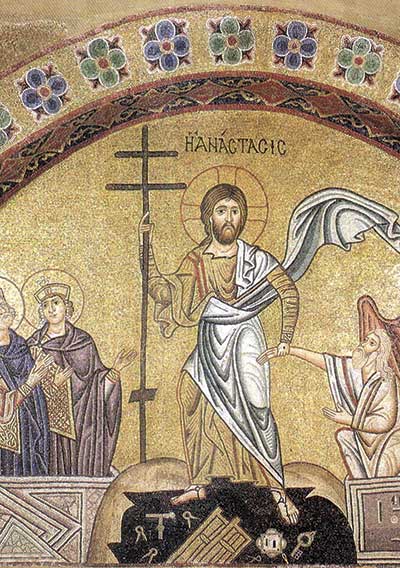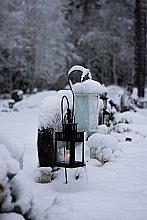Easter Week

[Hosios Loukas, Harrowing of Hell—anonimus / public domain, wikimedia]
Easter Sunday
Do you not know that all of us who have been baptized into Christ Jesus were baptized into his death? Therefore we have been buried with him by baptism into death, so that, just as Christ was raised from the dead by the glory of the Father, so we too might walk in newness of life. For if we have been united with him in a death like his, we will certainly be united with him in a resurrection like his. We know that our old self was crucified with him so that the body of sin might be destroyed, and we might no longer be enslaved to sin. For whoever has died is freed from sin. But if we have died with Christ, we believe that we will also live with him. We know that Christ, being raised from the dead, will never die again; death no longer has dominion over him. The death he died, he died to sin, once for all; but the life he lives, he lives to God. So you also must consider yourselves dead to sin and alive to God in Christ Jesus.
(Romans 6:3–11)
As they entered the tomb, they saw a young man, dressed in a white robe, sitting on the right side; and they were alarmed. But he said to them, “Do not be alarmed; you are looking for Jesus of Nazareth, who was crucified. He has been raised; he is not here. Look, there is the place they laid him. But go, tell his disciples and Peter that he is going ahead of you to Galilee; there you will see him, just as he told you.”
(Mark 16:5–7)
Monday, Easter Week
Come, ye faithful, raise the strain
of triumphant gladness!
God has brought his Israel
into joy from sadness.
—John of Damascus (c. 675–754), translated by John Mason Neale (1818–1866)
The competition for my favorite Easter hymn is steep, but this is at or near the very top. John of Damascus, who originally wrote its lyrics in Greek, was among the most famous of Eastern Christian saints. His text connects Christ’s Resurrection to the Old Testament story of the Exodus, to the yearly coming of spring, and to the expectant waiting of the disciples—concluding that “Neither could the gates of death, nor the tomb’s dark portal, / nor the watchers nor the seal hold him as a mortal.”
As I was first being drawn toward Anglicanism about 20 years ago, I attended an Easter Vigil service at our church in New Jersey. The Vigil traditionally begins fairly late at night and can take several hours. We had lit the “new fire” and proclaimed the light of Christ, we had heard the rehearsal of salvation history in numerous readings from the Old Testament while sitting in a sanctuary lit only by candlelight, and then at long last, we had erupted with great joy into the “Gloria in excelsis deo.”
As the organ—silent since Maundy Thursday—thundered, the lights came on at full blast to reveal a church blazing with flowers; the choir, in our best vestments, streamed into the choir loft. It was well after midnight, and we entered to this hymn. A dear saint from the church, who had sung in the choir, had recently died. I looked across the choir loft to her empty place as I took up the opening lines of “Come Ye Faithful, Raise the Strain.”
There are moments that reach deeper than any words can say. If we truly confront what the Resurrection of Christ means, it will touch us in that place beyond words and beyond sorrow where there is only awe. The Lord is risen; he is risen indeed.—Jennifer Woodruff Tait
Tuesday, Easter Week
We, little fishes, after the image of our Ichthys, Jesus Christ, are born in the water.
—Tertullian (c. 155–c. 220), On Baptism
In those early days of Christianity, when believers suffered persecution, it is believed they identified one another by the “sign of the fish.” You may be familiar with the symbol—although today, instead of as a marker of safe gathering places for Christians, you’ve probably seen it as a decal on someone’s car. And maybe others have asked you: what in the world do fish have to do with Jesus?
The word Ichthys—“fish” in Koine Greek—doubled as an acrostic with the letters standing for Iēsoûs Khrīstós, Theoû Huiós, Sōtér; or in English: “Jesus Christ, Son of God, Savior.”
Tertullian seems to play on this simple, clever creed of early believers in his quotation.
When we, little reflections of our Savior, obey his command to be baptized in his name, we picture our belief, rebirth, and identification with our Ichthys and confess the truth of who he is.
My church tradition baptizes professing believers through full immersion, and I’m fond of how this mode pictures what Romans 6 describes. The believer goes down in the water buried with Jesus in his death and then emerges, raised with Jesus by the glory of the Father to walk in the newness of life. While we could argue about modes of baptism until the Lord returns, we can certainly agree about its significance to our identity. In the water, we little fishes attest: Jesus Christ, Son of God, Savior. Amen! —Kaylena Radcliff
Wednesday, Easter Week
Now the green blade riseth, from the buried grain,
Wheat that in dark earth many days has lain;
Love lives again, that with the dead has been:
Love is come again like wheat that springeth green.
—John Macleod Campbell Crum (1872–1958)
One night, shortly into our first pandemic Easter season in April, 2020, my then-seven-year-old daughter asked me to sing her an “Easter song” when I put her to sleep.
“Most Easter songs are pretty peppy,” I said. “I don’t think they would put you to sleep.”
“Are there any quiet Easter songs?” she asked.
“Well, there’s ‘Now the Green Blade Riseth,’” I said. And I sang it for her.
It’s now become one of “our” songs and a frequent lullaby request. It’s a rather unique Easter hymn—far more contemplative than majestic. When the Oxford Book of Carols was being compiled in 1928, the editors wanted an English-language text that could be sung to a haunting medieval French Christmas carol tune called Noël Nouvelet. J. M. C. Crum, who provided the needed hymn text, was by all accounts a dedicated Church of England priest; while he wrote a few devotional books, this is by far his most famous composition.
Somehow, the haunting melody and careful attention to those devastating three days when Jesus was “with the dead” made this song a consoling choice for a pandemic Easter. In the final verse, Crum reminds us that when we are “wintry, grieving, or in pain,” Jesus can recall us to life. If grief or tragedy or loneliness has transcribed your Easter into a minor key, seek comfort from the Lord who knew death and brought life.—Jennifer Woodruff Tait
Thursday, Easter Week
Because Christ humbled Himself even to the death of the Cross, from love and obedience to God, it behooved Him to be uplifted by God to a glorious resurrection.
—Thomas Aquinas (1225–1274), Summa Theologiae III.53
On a cold January evening in 2018, I entered an old funeral parlor on South Broad Street in Philadelphia. This was not just any funeral parlor, but one that once acted as a well-known front for the Philadelphia mob and a notorious drug house. So, besides performing services for the deceased, this decrepit place contributed to the hatred, violence, and general malaise of the city. In every way imaginable, it was a house of death, covered in a shroud of darkness.
But there I was, eagerly entering the front door in anticipation of a spiritually rich and casserole-filled evening. You see, this bit of blight has undergone a radical transformation . . . a sort of resurrection! It is the newest location of Circle of Hope Church, a missional body seeking to “create an environment where people can connect with God and act for redemption.”
Where mob bosses and drug dealers once reigned, a church has been born. Where the neighbors once feared to tread, the doors have been opened wide. As a guest that evening, I enjoyed a vibrant time of worship followed by a tasty meal with new friends. The cheerful wildflowers tied with colorful ribbons onto columns all around the room seemed to perfectly represent the new life that spilled from this reborn building out into the community.
As we enter the coming weeks of Easter, take time to notice signs of resurrection hope in your own community. If you have trouble finding them, ask God to show you ways you might bring a fresh wind of the Spirit to your neighborhood.—Dawn Moore
Friday, Easter Week
What had become of the Redemption of the whole Body of Mankind, if they had not cause to believe the Message that the Lord Jesus sent by these Women, of and concerning his Resurrection?
—Margaret Fell (1614–1702), Women’s Speaking Justified, Proved, and Allowed by the Scriptures
The Resurrection is one of my favorite stories in the whole Bible. Not only is Jesus’s Resurrection from the dead at the crux of our whole faith, but God entrusts this good news to a handful of women. The good news of the Resurrection doesn’t first come to the king or the governor or the priest or even to Peter. It’s a humble group of women, who had come to the tomb in their grief to care for Jesus’s dead body, who first learn what’s happened. They’re just doing what women have done for centuries—the hard and holy work of quietly caring for loved ones behind the scenes. And there the angel entrusts them with a most important message of redemption.
If it’s surprising today, it would have been shocking in the first century. How could a few women be the first to hear and proclaim the good news of the Resurrection? Surely they hadn’t understood what the angel meant. As Luke tells the story, Jesus’s disciples did not believe the women. Not at first anyway. “It seemed to them an idle tale,” Luke reported. But the women knew what they had seen and heard. And eventually the men would believe too.
In my own life, this story has been good news to me as I’ve embraced God’s call to become a pastor and preacher—to speak the good news of Jesus’s Resurrection as a woman. If you’ve ever felt like God couldn’t possibly choose you for whatever reason, how might this story be good news to you? And if you’ve never questioned that God can and does call you, who else is speaking good news that you might need to listen to, especially if they seem like the “wrong person” for God to choose?—Michelle Curtis
Saturday, Easter Week
Even on the cross He did not hide Himself from sight; rather, He made all creation witness to the presence of its Maker. Then, having once let it be seen that it was truly dead, He did not allow that temple of His body to linger long, but forthwith on the third day raised it up, impassable and incorruptible, the pledge and token of His victory.
—Athanasius (c. 296–373), On the Incarnation
The miracle of the Resurrection looms large in humanity’s collective consciousness. From best-selling books to the silver screen, we cannot get enough of resurrection stories. We cheer when the hero, fallen in that most final defeat, rises whole and triumphant over death. And it’s not just a modern phenomenon. Go back to the oldest civilizations on Earth, and see it written across their mythologies. Our fascination displays our hearts. Deep down we recognize our dying state for what it truly is: a curse in desperate need of breaking.
Even so, ostensibly missing from many of those same narratives are a satisfying how and why. We recognize the curse and our fate because of it, but what can reverse it? Who can deliver us from our bodies of death?
Thanks be to God through Jesus Christ our Lord! We find our answer in him. This beautiful truth, fleshed out in Romans and commented on here by Athanasius, shows that our Maker who gave life to the universe was really, undeniably dead. But the grave could not hold him. He rose again, perfect and incorruptible, triumphant over sin and death for eternity.
Christian, remember today that the Resurrection story is your story. God’s triumph and miracle are gifts to you. “For God so loved the world, that he gave his only begotten son, that whoever believes in Him will not perish but have eternal life” (John 3:16). Wherever you find yourself in the race, remember it has already been won. His victory is yours, and it’s yours forever. —Kaylena Radcliff
By CHI Staff and Associates
[Christian History originally published this article in Christian History Issue #143+ in 2022]
Next articles
Day 1. A Lantern for the Stable
The shepherds laid aside their plans and chose to present themselves to Emmanuel.
Diana Pavlac GlyerDay 2. Loving Others Through Prayer
Why should my prayer be powerless to help another?
Robert TrexlerDay 3. Love your brother and sister
Does a bullying boss or corrupt politician matter to God?
Suzanne BraySupport us
Christian History Institute (CHI) is a non-profit Pennsylvania corporation founded in 1982. Your donations support the continuation of this ministry
Donate






